Benevento
| Benevento | |||
|---|---|---|---|
| Comune | |||
| Comune di Benevento | |||
|
Main landmarks in Benevento. Clockwise from the upper left: the Arch of Trajan, the church of Santa Sofia, the Cathedral's main portal, the castle and the Roman theatre | |||
| |||
 Benevento within the Province of Benevento | |||
 Benevento Location of Benevento in Italy | |||
| Coordinates: 41°08′N 14°47′E / 41.133°N 14.783°E | |||
| Country | Italy | ||
| Region | Campania | ||
| Province / Metropolitan city | Benevento (BN) | ||
| Frazioni | see list | ||
| Government | |||
| • Mayor | Clemente Mastella | ||
| Area | |||
| • Total | 129 km2 (50 sq mi) | ||
| Elevation | 135 m (443 ft) | ||
| Population (31 August 2015) | |||
| • Total | 60,169 | ||
| • Density | 470/km2 (1,200/sq mi) | ||
| Demonym(s) | Beneventani | ||
| Time zone | CET (UTC+1) | ||
| • Summer (DST) | CEST (UTC+2) | ||
| Postal code | 82100 | ||
| Dialing code | 0824 | ||
| Patron saint | St. Bartholomew | ||
| Saint day | August 24 | ||
| Website | Official website | ||
.jpg)
Benevento [beneˈvɛnto] ![]() listen (Neapolitan: Beneviento) is a city and comune of Campania, Italy, capital of the province of Benevento, 50 kilometres (31 mi) northeast of Naples. It is situated on a hill 130 metres (427 feet) above sea level at the confluence of the Calore Irpino (or Beneventano) and the Sabato. It is also the seat of a Roman Catholic archbishop.
listen (Neapolitan: Beneviento) is a city and comune of Campania, Italy, capital of the province of Benevento, 50 kilometres (31 mi) northeast of Naples. It is situated on a hill 130 metres (427 feet) above sea level at the confluence of the Calore Irpino (or Beneventano) and the Sabato. It is also the seat of a Roman Catholic archbishop.
Benevento occupies the site of the ancient Beneventum, originally Maleventum or still earlier Maloenton. The "-vent" portion of the name probably refers to a market-place and is a common element in ancient place names.[1] The Romans theorized that it meant "the site of bad events", from Mal(um) + eventum. In the imperial period it was supposed to have been founded by Diomedes after the Trojan War.[2]
Due to its artistic and cultural significance, the Santa Sofia Church in Benevento was declared a UNESCO World Heritage Site in 2011, as part of a group of seven historic buildings inscribed as Longobards in Italy, Places of Power (568–774 A.D.).
A patron saint of Benevento is Saint Bartholomew, the Apostle, whose relics are kept here at San Bartolomeo Cathedral.
History
Ancient era
Benevento, as Maleventum, was one of the chief cities of Samnium, situated on the Via Appia at a distance of 51 kilometres (32 mi) east from Capua on the banks of the river Calor (modern Calore). There is some discrepancy as to the people to which it belonged at contact: Pliny expressly assigns it to the Hirpini; but Livy certainly seems to consider it as belonging to the Samnites proper, as distinguished from the Hirpini; and Ptolemy adopts the same view.[3] All ancient writers concur in representing it as a very ancient city; Solinus and Stephanus of Byzantium ascribe its foundation to Diomedes; a legend which appears to have been adopted by the inhabitants, who, in the time of Procopius, pretended to exhibit the tusks of the Calydonian Boar in proof of their descent.[4] Festus, on the contrary (s. v. Ausoniam), related that it was founded by Auson, a son of Ulysses and Circe; a tradition which indicates that it was an ancient Ausonian city, previous to its conquest by the Samnites. But it first appears in history as a Samnite city;[5] and must have already been a place of strength, so that the Romans did not venture to attack it during their first two wars with the Samnites. It appears, however, to have fallen into their hands during the Third Samnite War, though the exact occasion is unknown.
Benevento was certainly in the power of the Romans in 274 BC, when Pyrrhus was defeated in a great battle, fought in its immediate neighborhood, by the consul Curius Dentatus.[6] Six years later (268 BC) they further sought to secure its possession by establishing there a Roman colony with Latin rights.[7] It was at this time that it first assumed the name of Beneventum, having previously been called Maleventum, a name which the Romans regarded as of evil augury, and changed into one of a more fortunate signification.[8] It is probable that the Oscan or Samnite name was Maloeis, or Malieis (Μαλιείς in Ancient Greek), whence the form Maleventum would derive, like Agrigentum from Acragas (modern Agrigento), Selinuntium from Selinus (the ruins of which are at modern Selinunte), etc.[9]
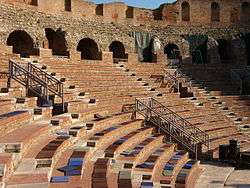
As a Roman colony Beneventum seems to have quickly become a flourishing place; and in the Second Punic War was repeatedly occupied by Roman generals as a post of importance, on account of its proximity to Campania, and its strength as a fortress. In its immediate neighborhood were fought two of the most decisive actions of the war: the Battle of Beneventum, (214 BC), in which the Carthaginian general Hanno was defeated by Tiberius Gracchus; the other in 212 BC, when the camp of Hanno, in which he had accumulated a vast quantity of corn and other stores, was stormed and taken by the Roman consul Quintus Fulvius Flaccus.[10] And though its territory was more than once laid waste by the Carthaginians, it was still one of the eighteen Latin colonies which in 209 BCE were at once able and willing to furnish the required quota of men and money for continuing the war.[11] No mention of it occurs during the Social War, although it seems to have escaped from the calamities which at that time befell so many cities of Samnium; towards the close of the Roman Republic Benevento is described as one of the most opulent and flourishing cities of Italy.[12]
Under the Second Triumvirate its territory was portioned out by the Triumvirs to their veterans, and subsequently a fresh colony was established there by Augustus, who greatly enlarged its domain by the addition of the territory of Caudium (modern Montesarchio). A third colony was settled there by Nero, at which time it assumed the title of Concordia; hence we find it bearing, in inscriptions of the reign of Septimius Severus, the titles Colonia Julia Augusta Concordia Felix Beneventum.[13] Its importance and flourishing condition under the Roman Empire is sufficiently attested by existing remains and inscriptions; it was at that period unquestionably the chief city of the Hirpini, and probably, next to Capua, the most populous and considerable city of southern Italy. For this prosperity it was doubtless indebted in part to its position on the Via Appia, just at the junction of the two principal arms or branches of that great road, the one called afterwards the Via Trajana, leading thence by Aequum Tuticum into Apulia; the other by Aeclanum to Venusia (modern Venosa) and Tarentum (modern Taranto).[14] Its wealth is also evidenced by the quantity of coins minted by Beneventum. Horace famously notes Beneventum on his journey from Rome to Brundusium (modern Brindisi).[15] It was indebted to the same circumstance for the honor of repeated visits from the emperors of Rome, among which those of Nero, Trajan, and Septimus Severus, are particularly recorded.[16]
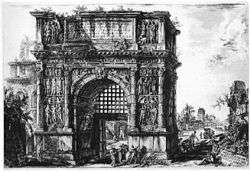
It was probably for the same reason that the triumphal arch, the Arch of Trajan, was erected there by the senate and people of Rome and constructed by the architect Apollodorus of Damascus in 114. The Arch of Trajan is one of the best-preserved Roman structures in the Campania. It repeats the formula of the Arch of Titus in the Roman Forum, with reliefs of Trajan's life and exploits of his reign. Some of the sculptures are in the British Museum. Successive emperors seem to have bestowed on the city accessions of territory, and erected, or at least given name to, various public buildings. For administrative purposes it was first included, together with the rest of the Hirpini, in the second region of Augustus, but was afterwards annexed to Campania and placed under the control of the consular of that province. Its inhabitants were included in the Stellatine tribe.[17] Beneventum retained its importance down to the close of the Empire, and though during the Gothic wars it was taken by Totila, and its walls razed to the ground, they were restored, as well as its public buildings, shortly after; and P. Diaconus speaks of it as a very wealthy city, and the capital of all the surrounding provinces.[18]
Beneventum indeed seems to have been a place of much literary cultivation; it was the birthplace of Orbilius the grammarian, who long continued to teach in his native city before he removed to Rome, and was honored with a statue by his fellow-townsmen; while existing inscriptions record similar honors paid to another grammarian, Rutilius Aelianus, as well as to orators and poets, apparently only of local celebrity.[19]
The territory of Beneventum under the Roman Empire was of very considerable extent. Towards the west it included that of Caudium, with the exception of the town itself; to the north it extended as far as the river Tamarus (modern Tammaro), including the village of Pago Veiano, which, as we learn from an inscription, was anciently called Pagus Veianus; on the northeast it comprised the town of Aequum Tuticum (modern Sant'Eleuterio, near Castelfranco in Miscano), and on the east and south bordered on the territories of Aeclanum and Abellinum. An inscription has preserved to us the names of several of the pagi or villages dependent upon Beneventum, but their sites cannot be identified.[20]
The city's most ancient coins bear the legend "Malies" or "Maliesa", which have been supposed to belong to the Samnite, or pre-Samnite, Maleventum. Coins with the legend "BENVENTOD" (an old Latin – or Samnite – form for Beneventor-um), must have been struck after it became a Latin colony.[21]
Duchy of Benevento
Not long after it had been sacked by Totila and its walls razed (545), Benevento became the seat of a powerful Lombard duchy.[2] The circumstances of the creation of duchy of Benevento are disputed. Lombards were present in southern Italy well before the complete conquest of the Po Valley: the duchy would have been founded in 576 by some soldiers led by a Zotto, autonomously from the Lombard king.

Zotto's successor was Arechis I (died in 640), from the Duchy of Friuli, who captured Capua and Crotone, sacked the Byzantine Amalfi but was unable to capture Naples. After his reign the Eastern Roman Empire had left in southern Italy only Naples, Amalfi, Gaeta, Sorrento, the tip of Calabria and the maritime cities of Apulia.
In the following decades, Benevento conquered some territories to the Roman-Byzantine duchy, but the main enemies was now the northern Lombard reign itself. King Liutprand intervened in several times imposing a candidate of his own to the duchy's succession; his successor Ratchis declared the duchies of Spoleto and Benevento foreign countries where it was forbidden to travel without a royal permission.
With the collapse of the Lombard kingdom in 773, Duke Arechis II was elevated to Prince under the new empire of the Franks, in compensation for having some of his territory transferred back to the Papal States. Benevento was acclaimed by a chronicler as a "second Pavia"— Ticinum geminum— after the Lombard capital was lost. The unit of this principality was short-lived: in 851, Salerno broke off under Siconulf and, by the end of that century, Capua was independent as well. Benevento was ruled again by Byzantines between 891-895.
The so-called Langobardia minor was unified for the last time by Duke Pandolfo Testa di Ferro, who expanded his extensive control in the Mezzogiorno from his base in Benevento and Capua. Before his death (March 981), he had gained from Emperor Otto I the title of Duke of Spoleto also. However, both Benevento and Salerno rebelled to his son and heir, Pandulf II.
The first decades of the 11th century saw two more German-descended rulers to southern Italy: Henry II, conquered in 1022 both Capua and Benevento, but returned after the failed siege of Troia. Similar results obtained Conrad II in 1038. In these years the three states (Benevento, Capua, and Salerno) were often engaged in local wars and disputes that favoured the rise of the Normans from mercenaries to ruler of the whole southern Italy. The greatest of them was Robert Guiscard, who captured Benevento in 1053 after the Emperor Henry III had first authorised its conquest in 1047 when Pandulf III and Landulf VI shut the gates to him. These princes were later expelled from the city and then recalled after the pope failed to defend it from Guiscard. The city fell to Normans in 1077. It was a papal city until after 1081.
Papal rule
Benevento passed to the Papacy peacefully when the emperor Henry III ceded it to Leo IX, in exchange for the Bishopric of Bamberg (1053). Landulf II, Archbishop of Benevento, promoted reform, but also allied with the Normans. He was deposed for two years. Benevento was the cornerstone of the Papacy's temporal powers in southern Italy. The Papacy ruled it by appointed rectors, seated in a palace, and the principality continued to be a papal possession until 1806, when Napoleon granted it to his minister Talleyrand with the title of Sovereign Prince. Talleyrand was never to settle down and actually rule his new principality; in 1815 Benevento was returned to the papacy. It was united with Italy in 1860.[2]
Manfred of Sicily lost his life in 1266 in battle with Charles of Anjou not far from the town, in the course of the Battle of Benevento.[2]
Jewish history
Epigraphical evidence show that a Jewish community had existed in Benevento since the fifth century at least.[22][23] At the 10th century, Jewish traveller Ahimaaz ben Paltiel describes in his chronicle the Jewish community of Benevento, among other southern Italy towns.[24] One of his relatives established a Yeshiva in town and a large part of his family ended residing in Benevento.[25] In 1065, prince Landulf IV of Benevento forced a number of Jews to convert to Christianity. He was reproved for doing that by Pope Alexander II.[26] When Jewish traveller Benjamin of Tudela visited Benevento in 1159 or 1165, he described 200 Jewish families living in it.[27][28] Being under Papal rule (unlike the rest of southern Italy), the Jewish community of Benevento was not expelled, as most other southern Italy Jewish communities in 1541.[22] Nevertheless, they were expelled from town later on 1569, under Pope Paul IV.[22] In 1617 the Jewish community was given permission to settle back in town, though 13 years later they were expelled once again after being accused of Well poisoning.[22] Since then, there was no organized Jewish community in Benevento.[29] Nevertheless, Jews had lived in Benevento in an unorganized manner during the past centuries, in addition to a few Israeli Jews living in town in recent years, occasionally suffering of Anti-Semitic incidents.[30][31]
Main sights
Ancient remains

The importance of Benevento in classical times is vouched for by the many remains of antiquity which it possesses, of which the most famous is the triumphal arch erected in honour of Trajan by the senate and people of Rome in 114, with important reliefs relating to its history. Enclosed in the walls, this construction marked the entrance in Benevento of the Via Traiana, the road built by the Spanish emperor to shorten the path from Rome to Brindisi. The reliefs show the civil and military deeds of Trajan.
There are other considerable remains from ancient era:
- The well-preserved ancient theatre, next to the Cathedral and the Port'Arsa gate. This grandiose building was erected by Hadrian, and later expanded by Caracalla. It had a diameter of 90 meters and could house up to 10,000 (or 15,000) spectators. It is currently used for theatre, dance, and opera performances.
- A large cryptoporticus 60 m long, known as the ruins of Santi Quaranta, and probably an emporium. According to Meomartini, the portion preserved is only a fraction of the whole, which once measured 520 m in length.
- A brick arch called Arco del Sacramento.
- The Ponte Leproso, a bridge on the Via Appia over the Sabato river, below the city center.
- Thermae along the road to Avellino.
- The Bue Apis, popularly known as A ufara ("buffalo"). It is a basement in the shape of an ox or bull coming from the Temple of Isis.
Many inscriptions and ancient fragments may be seen built into the old houses. In 1903 the foundations of the Temple of Isis were discovered close to the Arch of Trajan, and many fragments of fine sculptures in both the Egyptian and the Greco-Roman style belonging to it were found. They had apparently been used as the foundation of a portion of the city wall, reconstructed in 663 under the fear of an attack by the Byzantine emperor Constans II, the temple having been destroyed by order of the bishop, St Barbatus, to provide the necessary material (A. Meomartini, 0. Marucchi and L. Savignoni in Notizie degli Scavi, 1904, 107 sqq.).
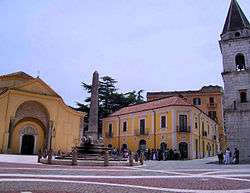
Santa Sofia
The church of Santa Sofia is a circular Lombard edifice dating to c. 760, now modernized, of small proportions, and is one of the main examples of religious Lombard architecture. The plan consists of a central hexagon with, at each vertex, columns taken from the temple of Isis; these are connected by arches which support the cupola. The inner hexagon is in turn enclosed in a decagonal ring with eight white limestone pillars and two columns next to the entrance. The church has a fine cloister of the 12th century, constructed in part of fragments of earlier buildings.[2] The church interior was once totally frescoed by Byzantine artists: fragments of these paintings, portraying the Histories of Christ, can be still seen in the two side apses.
Santa Sofia was almost destroyed by the earthquake of 1688, and rebuilt in Baroque forms by commission of the then cardinal Orsini of Benevento (later Pope Benedict XIII). The original forms were hidden, and were recovered only after the discussed restoration of 1951.
In 2011, it became a UNESCO World Heritage Site as part of a group of seven inscribed as Longobards in Italy, Places of Power (568-774 A.D.).
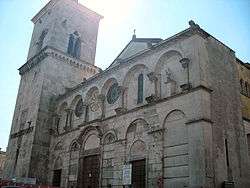
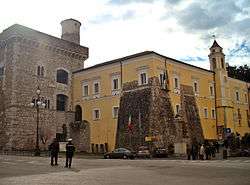
The Cathedral
The Cathedral of Santa Maria Assunta, with its arcaded façade and incomplete square campanile (begun in 1279 by the archbishop Romano Capodiferro) dates from the 9th century.[2] It was rebuilt in 1114, the façade inspired by the Pisan Gothic style. Its bronze doors, adorned with bas-reliefs, are notable example of Romanesque art which may belong to the beginning of the 13th century. The interior is in the form of a basilica, the double aisles carried on ancient columns. There are ambones resting on columns supported by lions, and decorated with reliefs and coloured marble mosaic, and a candelabrum of 1311.[2] A marble statue of the apostle San Bartolomeo, by Nicola da Monteforte, is also from the 14th century. The cathedral also contains a statue of St. Giuseppe Moscati, a native of the area.
Rocca dei Rettori
The castle of Benevento, best known as Rocca dei Rettori or Rocca di Manfredi, stands at the highest point of the town, commanding the valley of the rivers Sabato and Calore, and the two main ancient roads Via Appia and Via Traiana. The site had been already used by the Samnites, who had constructed here a set of defensive terraces, and the Romans, with a thermal plant (Castellum aquae), whose remains can be still seen in the castle garden. The Benedictines had a monastery there. It received the current name in the Middle Ages, when it became the seat of the Papal governors, the Rettori.
The castle is in fact made by two distinct edifices: the Torrione ("Big Tower"), which was built by the Lombards starting from 871, and the Palazzo dei Governatori, built by the Popes from 1320.
Other sights
- The Roman theatre (2nd century).
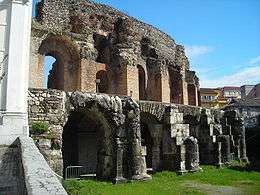 The Roman theatre.
The Roman theatre. - Sant'Ilario, not far from the Arch of Traian along the first trait of the Via Traiana, is a very ancient, small building dating from the end of the 6th or the beginning of the 7th century.
- The Palazzo di Paolo V (16th century).
- The church of San Salvatore, dating from the High Middle Ages.
- The Gothic church of San Francesco alla Dogana.
- The Baroque churches of Annunziata, San Bartolomeo and San Filippo.
Territorial subdivisions
Frazioni, or wards, include: Acquafredda, Cancelleria, Capodimonte, Caprarella, Cardoncielli, Cardoni, Cellarulo, Chiumiento, Ciancelle, Ciofani, Cretazzo, Epitaffio, Francavilla, Gran Potenza, Imperatore, Lammia, Madonna della Salute, Masseria del Ponte, Masseria La Vipera, Mascambruni, Montecalvo, Olivola, Pacevecchia, Pamparuottolo, Pantano, Perrottiello, Piano Cappelle, Pino, Ponte Corvo, Rosetiello, Ripa Zecca, Roseto, Santa Clementina, San Chirico, San Cumano (anc. Nuceriola), San Domenico, San Giovanni a Caprara, Sant'Angelo a Piesco, San Vitale, Scafa, Serretelle, Sponsilli, Torre Alfieri, and Vallereccia .
Economy
The economy of Benvento area is traditionally agricultural. Main products include vine, olives and tobacco. The main industry is that of food processing (sweets and pasta), although textile, mechanics and construction companies are present.
Sports
The Stadio Ciro Vigorito is a multi-use stadium in Benevento, which is mostly used as the home venue of Serie B side Benevento Calcio.
Transportation
Benvento is connected to Naples through the modern SS7 Appia state road, and then local roads starting from Arienzo. It is 17 kilometres (11 miles) from the Naples-Bari A16 motorway. The SS372 Telesina state road allows reaching the A1 Naples-Rome, leading to the latter in less than three hours.
Benevento railway station, on the Caserta-Foggia railway, has fast connections from Rome to Avellino, Bari and Lecce. Trains to Campobasso have been mostly replaced by bus services. The connection to Naples is ensured by three stations on the MetroCampania NordEst inter-urban metro line.
Airports
The nearest airports are:
- Salerno-Pontecagnano (QSR) 89 km
- Napoli-Capodichino (NAP) 91 km
People
- Saint Giuseppe Moscati, a doctor, was born here in 1880, the first modern physician designated a saint by the Catholic Church
- Padre Pio, real name Francesco Forgione, one of the most important saints of the modern Catholic Church
- Januarius, Bishop of Naples, is a martyr saint of the Roman Catholic and the Eastern Orthodox Churches. While no contemporary sources on his life are preserved, later sources and legends claim that he died during the Diocletianic Persecution,[2] which ended with Diocletian's retirement in 305.Januarius is the patron saint of Naples, where the faithful gather three times a year in Naples Cathedral to witness the alleged liquefaction of what is claimed to be a sample of his blood kept in a sealed glass ampoule.
- Immanuel Ben Jekuthiel of Benevento, a Jewish grammarian and corrector of the press of Mantua in the 16th century. He was the author of the Jewish textbook Liwyat Hen (1557, Mantua).[32]
- Antonio Sancho de Benevento, a silversmith artist of the Spanish Renaissance and monk of the Monastery of Sant Jeroni de Cotalba, near Gandia (Valencia) in Spain
- Carlotta Nobile, Art historian, violinist, blogger and Art Director of Santa Sophia Academy chamber Orchestra in Benevento from September 2010 up to her death at the age of 24.
References
- ↑ E. McClure, British Place-Names in their Historical Settings, London (1910), pp. 32-34
- 1 2 3 4 5 6 7
 One or more of the preceding sentences incorporates text from a publication now in the public domain: Chisholm, Hugh, ed. (1911). "Benevento". Encyclopædia Britannica. 3 (11th ed.). Cambridge University Press. pp. 727–728.
One or more of the preceding sentences incorporates text from a publication now in the public domain: Chisholm, Hugh, ed. (1911). "Benevento". Encyclopædia Britannica. 3 (11th ed.). Cambridge University Press. pp. 727–728. - ↑ Pliny iii. 11. s. 16; Livy xxii. 13; Ptolemy iii. 1. § 67.
- ↑ Gaius Julius Solinus 2. § 10; Steph. B. s. v.; Procop. B. G. i. 15.
- ↑ Livy ix. 27.
- ↑ Plutarch Pyrrh. 25; Frontinus Strategemata iv. 1. § 14.
- ↑ Livy Epit. xv.; Velleius Paterculus i. 14.
- ↑ Pliny iii. 11. s. 16; Liv. ix. 27; Fest. s. v. Beneventum, p. 34; Steph. B. s. v.; Procop. B. G. i. 15.
- ↑ James Millingen, Numnismatique de l'Italie, p. 223.
- ↑ Liv. xxii. 13, xxiv. 14, 16, xxv. 13, 14, 15, 17; Appian, Annib. 36, 37.
- ↑ Livy xxvii. 10.
- ↑ Appian, B.C. iv. 3; Strabo v. p. 250; Cicero In Verrem i. 1. 5.
- ↑ Appian. l. c.; Lib. Colon. pp. 231, 232; Inscr. ap. Romanelli, vol. ii. pp. 382, 384; Orell. Inscr. 128, 590.
- ↑ Strabo vi. p. 283.
- ↑ Sat. i. 5, 71.
- ↑ Tacitus Ann. xv. 34.
- ↑ Pliny iii. 11. s. 16; Mommsen, Topogr. degli Irpini, p. 167, in Bull. dell'Inst. Arch. 1847.
- ↑ Procop. B. G. iii. 6; P. Diac. ii. 20; De Vita, Antiq. Benev. pp. 271, 286.
- ↑ Suet. Gram. 9; Orell. Inscr. 1178, 1185.
- ↑ Henzen, Tab. Aliment. Baebian, p. 93-108; Mommsen, Topogr. degli Irpini, p. 168-71.
- ↑ Millingen, Numismatique de l'Anc. Italie, p. 223; Friedländer, Osk. Münz. p. 67; McClure, British Place-Names etc., p. 33.
- 1 2 3 4 https://www.jewishvirtuallibrary.org/jsource/judaica/ejud_0002_0003_0_02457.html
- ↑ http://www.byzantinejewry.net/applications/mjcb/show_evidence_details.php?evidence_id=287
- ↑ Ahimaaz ben Paltiel
- ↑ Bonfil, Robert (2009). History and Folklore in a Medieval Jewish Chronicle. Leiden: Brill. p. 74. ISBN 978-90-04-17385-9.
- ↑ http://bnmal.it/sito/2013/06/ebrei-a-benevento-dal-ix-al-xvi-secolo/
- ↑ http://jewishencyclopedia.com/articles/2939-benevento
- ↑ Patai, Jennifer (1989). The Myth of the Jewish Race. Detroit: Wayne State University Press. p. 44. ISBN 0-8143-1948-3.
- ↑ Encyclopaedia Judaica: Ba-Blo, p. 341, at Google Books
- ↑ http://antisemitism.org.il/article/83571/swastikas-were-painted-store-ancient-city-benevento
- ↑ http://www.ntr24.tv/it/news/cronaca/benevento-via-iii-settembre-svastiche-su-un-negozio-del-centro-storico.html
- ↑ http://jewishencyclopedia.com/articles/8088-immanuel-ben-jekuthiel-of-benevento
Sources
 This article incorporates text from a publication now in the public domain: Smith, William, ed. (1854–1857). "article name needed". Dictionary of Greek and Roman Geography. London: John Murray.
This article incorporates text from a publication now in the public domain: Smith, William, ed. (1854–1857). "article name needed". Dictionary of Greek and Roman Geography. London: John Murray.- von Falkenhausen, Vera (1983). "I Longobardi meridionali". In Giuseppe Galasso ed. Il Mezzogiorno dai Bizantini a Federico II. Turin: UTET. pp. 251–364.
- Cilento, Nicola (1971). Italia meridionale longobarda. Milan-Naples: Ricciardi.
External links
| Wikimedia Commons has media related to Benevento. |
- The History Files: Independent Dukes (571–774) and Princes (774–1053) of Benevento
- Beneventan liturgical chant, c. 650 – c. 800
- Pictures from Benevento
- Photo Gallery by Leonardo Bellotti (Italian)
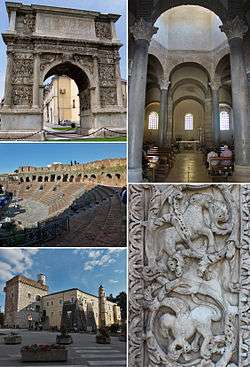

.png)
